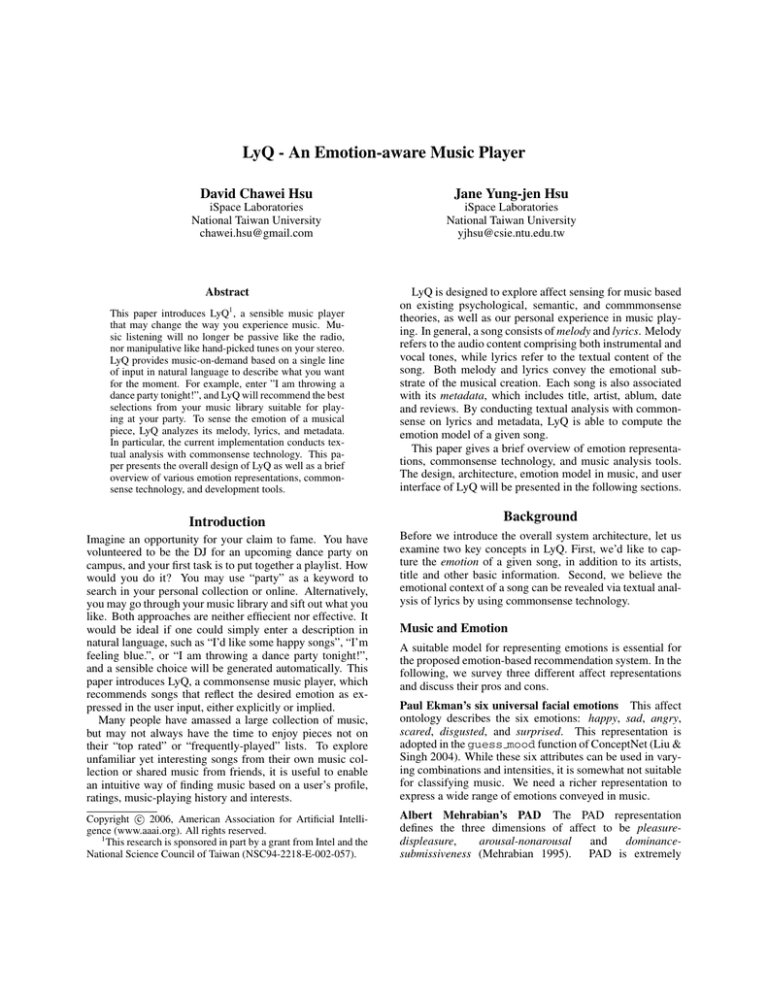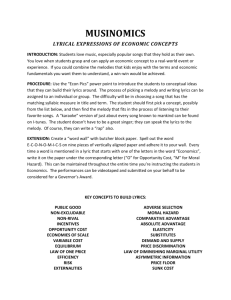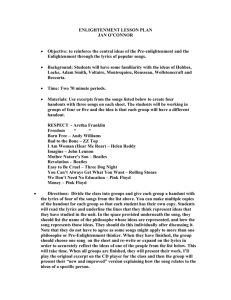
LyQ - An Emotion-aware Music Player
David Chawei Hsu
Jane Yung-jen Hsu
iSpace Laboratories
National Taiwan University
chawei.hsu@gmail.com
iSpace Laboratories
National Taiwan University
yjhsu@csie.ntu.edu.tw
Abstract
1
This paper introduces LyQ , a sensible music player
that may change the way you experience music. Music listening will no longer be passive like the radio,
nor manipulative like hand-picked tunes on your stereo.
LyQ provides music-on-demand based on a single line
of input in natural language to describe what you want
for the moment. For example, enter ”I am throwing a
dance party tonight!”, and LyQ will recommend the best
selections from your music library suitable for playing at your party. To sense the emotion of a musical
piece, LyQ analyzes its melody, lyrics, and metadata.
In particular, the current implementation conducts textual analysis with commonsense technology. This paper presents the overall design of LyQ as well as a brief
overview of various emotion representations, commonsense technology, and development tools.
LyQ is designed to explore affect sensing for music based
on existing psychological, semantic, and commmonsense
theories, as well as our personal experience in music playing. In general, a song consists of melody and lyrics. Melody
refers to the audio content comprising both instrumental and
vocal tones, while lyrics refer to the textual content of the
song. Both melody and lyrics convey the emotional substrate of the musical creation. Each song is also associated
with its metadata, which includes title, artist, ablum, date
and reviews. By conducting textual analysis with commonsense on lyrics and metadata, LyQ is able to compute the
emotion model of a given song.
This paper gives a brief overview of emotion representations, commonsense technology, and music analysis tools.
The design, architecture, emotion model in music, and user
interface of LyQ will be presented in the following sections.
Introduction
Background
Imagine an opportunity for your claim to fame. You have
volunteered to be the DJ for an upcoming dance party on
campus, and your first task is to put together a playlist. How
would you do it? You may use “party” as a keyword to
search in your personal collection or online. Alternatively,
you may go through your music library and sift out what you
like. Both approaches are neither effiecient nor effective. It
would be ideal if one could simply enter a description in
natural language, such as “I’d like some happy songs”, “I’m
feeling blue.”, or “I am throwing a dance party tonight!”,
and a sensible choice will be generated automatically. This
paper introduces LyQ, a commonsense music player, which
recommends songs that reflect the desired emotion as expressed in the user input, either explicitly or implied.
Many people have amassed a large collection of music,
but may not always have the time to enjoy pieces not on
their “top rated” or “frequently-played” lists. To explore
unfamiliar yet interesting songs from their own music collection or shared music from friends, it is useful to enable
an intuitive way of finding music based on a user’s profile,
ratings, music-playing history and interests.
Before we introduce the overall system architecture, let us
examine two key concepts in LyQ. First, we’d like to capture the emotion of a given song, in addition to its artists,
title and other basic information. Second, we believe the
emotional context of a song can be revealed via textual analysis of lyrics by using commonsense technology.
Paul Ekman’s six universal facial emotions This affect
ontology describes the six emotions: happy, sad, angry,
scared, disgusted, and surprised. This representation is
adopted in the guess mood function of ConceptNet (Liu &
Singh 2004). While these six attributes can be used in varying combinations and intensities, it is somewhat not suitable
for classifying music. We need a richer representation to
express a wide range of emotions conveyed in music.
c 2006, American Association for Artificial IntelliCopyright gence (www.aaai.org). All rights reserved.
1
This research is sponsored in part by a grant from Intel and the
National Science Council of Taiwan (NSC94-2218-E-002-057).
Albert Mehrabian’s PAD The PAD representation
defines the three dimensions of affect to be pleasuredispleasure,
arousal-nonarousal
and
dominancesubmissiveness (Mehrabian 1995). PAD is extremely
Music and Emotion
A suitable model for representing emotions is essential for
the proposed emotion-based recommendation system. In the
following, we survey three different affect representations
and discuss their pros and cons.
versatile and can be used to express a wide range of
emotions. For example, Ekman’s six emotions can be
easily described in terms of PAD values. When using
this representation in a musical domain, it’s better to
ignore the third dimension of dominance and focus on the
relationship between pleasure and arousal, since we can
see this observation in Affective Listener (Chung & Vercoe
2005) where positive pleasure and positive arousal results
in an engaging affective state. In contrast, a negative value
in both pleasure and arousal dimensions locates in a boring
affective state. The drawback of this representation is that
all possible moods need to be carefully mapped onto this
two-dimensional emotional coordinate.
Kate Hevner’s Adjective Circle The Kate Hevner’s
music-emotion representation maps many musical parameters onto a circle of emotional terms (Hevner 1936). The
circle as shown in Figure 1 is divided into eight groups of
closely related emotional adjectives. The eight emotional
states are angry, exciting, happy, playful, relaxed, sad, spiritual, and tender. This representation is better suited to musical applications than the previous two because it provides a
number of musical parameters to describe each mood.
al. 2002). This generic commonsense knowledge base is
contributed by web volunteers entering their commonsense
statements into the OMCS corpus. Until now, they have entered over 700,000 such statements. With this knowledge
it is possible to create innovative software that can solve everyday situations and problems or even produce a brand new
interaction with computers by using commonsense.
ConceptNet (Liu & Singh 2004) is a commonsense
knowledge base and natural-language-processing toolkit and
it automatically generates a commonsense network by using
the commonsense statements in the OMCS database. This
program offers many useful functions, such as topic-gisting,
affect-sensing, analogy-making, contextual expansion, etc..
Implementation
This section introduces the detailed design of our music
player as shown in Figure 2. The system is written in
Python, a high-level object-oriented language, and operated
on the Mac OS X platform. Following Figure 2, there are
three different types of input - query, textual content, and
acoustic content. A query is described in natural language
and given by the user. For example, a user may input a sentence such as “I’m throwing a dance party tonight!” that
shows the user’s emotion and desire. For any given song,
its textual content includes all textual components such as
metadata and lyrics; its acoustic content refers to the audio
component of the song. To extract important features, the
LyQ Analyzer adopts different models of evaluation based
on the input type. These extracted features are stored in the
Database, implemented in mySQL. According to the user’s
query, the Matcher searches for the top-five songs with similar implicit feeling and semantic meaning as the query sentence. Finally, LyQ recommends the matching songs to the
user.
Figure 1: Kate Hevner’s Adjective Circle
Commonsense Technology
Lyrics can be viewed as a concrete, implicit expression of
an abstract concept, which often makes listeners catch the
feeling of a song even without listening to it actually. Given
that lyrics are written in natural language by people, its content can be analyzed with the help of some commonsense
knowledge base. Commonsense knowledge, thusly defined,
spans a huge portion of human experience, encompassing
knowledge about the spatial, physical, social, temporal, and
psychological aspects of typical everyday life. As a result,
it makes sense to take advantage of ConceptNet’s affectsensing capabilities in creating this application.
Open Mind Common Sense (OMCS) is currently the second largest commonsense database in the world (Singh et
Figure 2: System Architecture
Textual Affect-sensing Model in Music Domain
This is the core part of the Analyzer with respect to textual
analysis. After surveying several emotional representations,
we decided to use Kate Hevner’s Adjective Circle to construct our affect-sensing model. An eight-tuple is used to
represent the dimensions of music mood, including angry,
exciting, happy, playful, relaxed, sad, spiritual, and tender.
Regardless of whether the input is a document or a sentence,
the end result will be represented as an emotion vector:
[a angry, b exciting, c happy, d playful, e relaxed, f sad, g
spiritual, h tender]
Each of these eight entries ranges from 0 to 1, representing the magnitude of each particular emotion.
Generating node-score file Following the affect sensing
approach by Liu et al (Liu, Lieberman, Selker 2003), we
propose to achieve music mood inferencing by carrying out
spreading activation in ConceptNet. For each iteration during spreading activation, the music mood value of a node in
ConceptNet is propagated outwards to its neighboring nodes
with a discount factor d = 0.25 in the prototype system.
A total of 30 descriptive words are defined as
the emotion grounds.
For example, we define the
word “party” to be one emotion ground with a tuple value [0.3, 0.8, 0.7, 0.6, 0.3, 0.1, 0.0, 0.5]. The emotion grounds begin propagating their values in ConceptNet using spreading activation. In previous experiments,
we tested the guess mood function in ConceptNet with
max node visits= 1000, which is a parameter determining how far the context will spread. The response time
may take 10 seconds approximately. To achieve our expected performance, the scores computed by spreading activation are cached in the node-score file.
Get the mood Any sentence is an input no matter query,
song title, or a sentence in lyrics. We obtain an extraction
object which contains a parsed digest of the text from the
get extraction function. Afterward, by matching the
same term which occurs in the node-score file, we receive
this emotion value. The flow diagram of getting mood features is clearly illustrated in Figure 3.
A local database is created automatically. Before rebuilding your local database, the system will check out any new
audio files that have never been analyzed previously. Otherwise, the local database will connect to the Internet and load
the default database from the LyQ website. This design produces high scalability, because all the necessary steps before
running the application are automatic.
After the system confirms the checklist that needs to be
analyzed, if the computer is online, the system will search
and obtain the metadata and lyrics from several available
websites which provide the information. Subsequently, by
sending this information to the Analyzer, LyQ generates and
returns extracted features to the Database.
Currently, we have collected 225 songs in our dataset, including famous bands like the Beatles, Jack Johnson, No
Doubt, Red Hot Chili Peppers, Blur, and many other different styles of performers. However, this dataset is still limited
in several genres, thus our next step is trying to collect more
various genres to test our system.
User Interface
Our interface is implemented by using Macromedia Flash
and Actionscript language which have the advantage in developing a user-friendly interface. This interface connects
with our main system via XML-RPC. In our first prototype
shown in Figure 4, users can simply enter one sentence in
natural language into the text entry under “Query” label, and
then press the “Search” button. Immediately, the system recommends at least 5 songs at the right-hand music player that
have the feeling similar to your sentence implied, and also
displays the mood values of your input sentence on the orange “Result” text field.
Figure 3: Flow Diagram of Getting Mood Features
Since lyrics can be considered as a special document or
maybe a poem which has been merged with a number of
sentences which show varying strength of emotions in every
paragraph, we memorize each sentence’s mood and position
in order to generate a global model with better prediction.
Generating Dataset
In this section, we introduce our database and dataset generation. The setup is simple and intuitive. The first thing you
need to do is to set the location path to your music folder
to avoid having the system scanning over the entire storage.
Figure 4: LyQ’s User Interface
User Study
Music comes from human beings, thus we desire music. In
order to get the feedback, we invited several different types
of music lovers to use our system. Their first reactions were
similar, most users thought it is an interesting and amazing
music player, especially the way of searching. But some of
them were still not familiar with this searching style. After our discussion, we bring out several ideas. First, based
on what behaviors users already have in traditional music
search, they remain using their favorite performers or songs
to describe what kind of music they love. Second, people
listen to music with desires. For example, when a person is
busy, he’d like to listen to the songs that makes him relaxed.
In summary, on the next music-on-demand generation,
we shall improve our interface and recommendation strategy to adapt users’ manners. For example, provide some
frequently existing options like genres, popularity or optionally ask users ”How do you feel right now?”, ”Why do you
want some music?”, ”Where do you gonna play?”, ”Whom
are you playing to?”, etc.. Those interactive ways might be
more intuitive and practical.
However, since we cannot suddenly change one’s mind,
we offer an innovative interface and concept for users and
recommend more suitable songs to them or even additionally
allure them to listen to variety of music according to their
backgrounds and profiles.
a song. The affect-sensing approach supports users to indirectly observe the relationship between melody and lyrics.
As a result, LyQ improves music emotion detection, which
is usually based on acoustic analysis in Music Information
Retrieval.
In the current stage, we have accomplished the textual
analysis components of LyQ, and our next target is to construct the acoustic analysis component. To assure the accuracy of LyQ, we need to combine both textual and acoustic
models On the other hand, people have different behaviors
in music listening. Some prefer to pay more attention in
melody but some in lyrics; some prefer popular but limited
range of songs, while others prefer alternatives and a wide
range of songs. Therefore, we should consider giving different weights to achieve personality, according to their profiles
and preferences. We have mentioned various listening experiences that may be considered in music entertainment of the
future. Our goal is to break up users’ present music-listening
behaviors and rules in exploring their own musical interests.
Related Work
Chung, J., and Vercoe, S. 2005. The affective listener.
http://courses.media.mit.edu/2005spring/mas630/05.proje
cts/AffectListener/index.html.
Hevner, K. 1936. Experimental studies of the elements of
expression in music. In American Journal of Psychology,
48 (1936), 246V268.
Liu, H., and Singh, P. 2004. Conceptnet: A practical commonsense reasoning toolkit. In BT Technology Journal, To
Appear. Volume 22, forthcoming issue. Kluwer Academic
Publishers.
Liu, H.; Lieberman, H.; and Selker, T. 2003. A model
of textual affect sensing using real-world knowledge. In
In Proceedings of the Seventh International Conference on
Intelligent User Interfaces, pages 125–132, 2003.
Mehrabian, A. 1995. The pad comprehensive emotion (affect, feeling) tests. http://www.kaaj.com/psych/
scales/emotion.html.
Meyers, O. 2005. Mysoundtrack: A commonsense playlist
generator. http://web.media.mit.edu/∼meyers/mysoundtra
ck.pdf.
Singh, P.; Lin, T.; Mueller, E.; Lim, G.; Perkins, T.; and
Zhu, W. 2002. Open mind common sense: Knowledge
acquisition from the general public. In Proceedings of the
First International Conference on Ontologies, Databases,
and Applications of Semantics for Large Scale Information Systems. Lecture Notes in Computer Science (Volume
2519). Heidelberg: Springer-Verlag.
University, T. L. 2003. Detecting emotion in music.
http://citeseer.ist.psu.edu/645004.html.
van de Laar, B. 2006. Emotion detection in music, a survey.
Yang, D., and Lee, W.
2004.
Disambiguating music emotion using software agents.
In ISMIR. http://ismir2004.ismir.net/proceedings/p011-page52-paper218.pdf.
References
Emotion-based music classification is gradually coming into
view on the web, such as All Music Guide, it provides more
than 210 emotional categories for classifying entire songs.
Each song is not only classified into one category, but can be
tagged with multiple categories, that means those categories
are not exclusive and also mentions that a realistic classification system should relax the strict classification paradigm.
It provides a brand new way of classifying and searching
music, but does not solve the problem of finding adequate
music for users.
Another music channel is listening to Internet Radio, such
as Yahoo! Music, Pandora, etc.. By entering an artist name
or song title, those online systems will create a personal radio station for you and play songs which have similar features and characteristics to the artist or the song title you
gave. According to the Pandora website, they claim that
they capture the unique and magical musical identity of a
song from melody, harmony and rhythm, to instrumentation, orchestration, arrangement, lyrics, and the rich world
of singing and vocal harmony. It seems like a really creative
project but requires lots of human resources in development.
Finally, a commonsense playlist generator, MySoundTrack (Meyers 2005), created by Owen Meyers in MIT Media Lab is carrying the similar idea as mine in creating an
innovative music recommendation system. Currently, the
functions we provide are in the homogeneous level, except the self-organizing ability and ease-to-setup attribute in
LyQ. In our following experiment, it is essential to compare
the results and the performance with those similar systems
in order to obtain a better solution.
Conclusion and Future Work
In this paper, we introduced an innovative interface to access
your personal music collection. Instead of the traditional
keyword-based search, LyQ offers a novel emotion-based
search interface that attempts to capture a deeper feeling in



